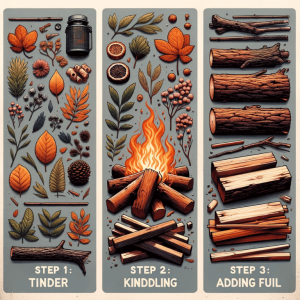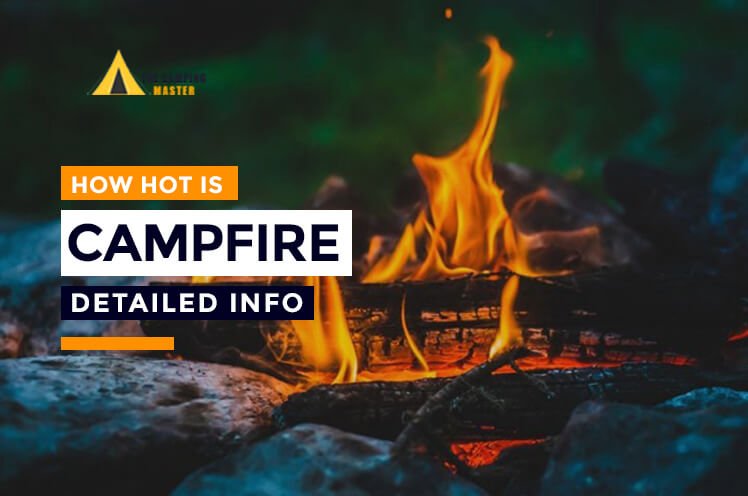Campfires are great for keeping you warm, lighting up the night, and cooking food when you’re outside. But sometimes, they can be tricky, especially regarding campfire cooking.
In this blog post, I will discuss how hot a campfire gets. I’ll answer the big question: ‘How hot is campfire?’ and show you how to determine the temperature yourself. I’ll also look at other things to consider with campfires, like what kind of pan is best for cooking over an open flame.
Ready to learn more? Let’s start our campfire adventure!
What is the Average Campfire Temperature?
So here, you need to know that different temperatures exist in different situations.
Cooking Temperature: In the area above the flames, referred to as the thermal plume region, where flames are not visible, temperatures should be around 600°F (320°C). Here is where you’ll prepare meals. The temperature decreases with increasing distance from the flames.
Internal Temperature: A campfire’s continuous flame zone, or flame temperature, can reach internal temperatures of 1650°F (900°C).
Large campfires temperature: large campfires, like bonfires, can reach temperatures of more than 2000°F (1100°C).
However, all the temperatures can be higher or lower depending on the kind of wood you choose. Utilizing a cooking thermometer is the best way to determine.
Factors That Effects Campfire Temperature Change
Now, let’s look at the factors that affect a campfire. As we already know, the temperature of a campfire can vary. Let’s learn more about these factors.
Type of Wood Used for Campfire
The main factor affecting the warmth of your fire is the type of wood you use. Compared to softwoods like pine, hardwoods like oak and maple will burn hotter. The heat generated by burning dry wood is also more than that generated by burning green or wet wood.
Hickory: A thick wood with low moisture absorption. It burns intensely yet might be challenging to chop. It is ideal for smoking and grilling meat and fish.
Oak: This hardwood burns slowly and generates heat without producing many sparks.
Ash: An excellent, lightweight firewood that grows in various habitats. It burns quickly and doesn’t produce a lot of smoke. Ash also breaks easily and retains little moisture.
Cedar: Even while cedar produces smaller flames than some other firewood on this list, it still generates a lot of heat. It’s perfect for keeping your camping comfortable and warm.
Best Wood for Campfire
Oak, hickory, or maple hardwoods. These woods produce hot, enduring fires.
Softwoods, such as cedar or pine. These types of wood burn quickly and emit numerous flames.
Fruitwoods, such as cherries or apples. These woods produce modest flames and have a pleasant aroma.
Construction Style
If you correctly style the wood, it will be much hotter than a pile of wood placed together randomly. So (how hot the campfire is)also depend on the construction style of the woods.
Shape and Size of the Fire
The temperature also depends on the size of your fire. As much as you add more wood to the campfire, the hotter it will get and the size of the fire. There is no doubt that a more extensive fire will be more burning than a smaller one, regardless of how big it is.
Oxygen
The amount of oxygen a campfire receives determines its temperature. Here the wind can be your greatest enemy, and lighting a fire in this situation can be challenging. Once a fire has started, the wind primarily supplies the flames with oxygen. When there is more oxygen present, fires always burn hotter.
The Duration of The Fire
The duration of the fire for how long your fire has been burning also affects the temperature measurement. A fire just getting started won’t be as hot as one that has already been burning for some time. Therefore, you’ll need to add more wood and let it burn for a while if you want a real fire.
In the above, I explain all types of campfire styles. You can read the details of how to get campfire smell out of my tent in my other article.
How to Build a Decent Campfire?
Here’s a simple guide on how to make a good campfire in three steps:

1. Tinder
Start by gathering fuel, which includes small, easily ignitable materials like dry leaves, grass, or small twigs. Arrange them in a small pile at your fire site, ensuring it’s a safe distance from flammable materials.
2. Kindling
Once your fuel is in place, add kindling, which consists of slightly larger sticks and branches. Arrange them over the fuel in a teepee shape to allow for good airflow, which is crucial for catching the fire.
3. Adding Fuel
Add larger pieces of wood as fuel after your kindling burns. Place them strategically around the burning kindling, not smothering the fire, to keep it burning steadily. As the larger pieces catch fire, you can add more to maintain your campfire.
How Hot Is My Campfire : 3 Best Methods
There are several techniques to determine this. You can use any of these methods in which you are comfortable to know how hot my campfire is.
No 1. Holding Your Hand Around 6 Inches Above the Flames
If you can control your palm there for 3–4 seconds, the fire is probably around 400 degrees Fahrenheit. It is safe to assume that the fire is about 600 degrees Fahrenheit if you can only keep your hand there for 1-2 seconds. The fire is over 800 degrees Fahrenheit if you can’t keep your hand there!
No 2. A Cooking Thermometer
These are only broad estimations, of course. Using a kitchen thermometer is the only way to be specific. In any event, it is essential to exercise caution at all times and to be safe whenever you are around a campfire.
No 3. Observing the Color of Flame
Observing the colour of the flames is the most exciting way to know a lot about how hot the campfire is.
White: It is probably rare colour that appears when the fire is scorching. The area of the flame, most likely in contact with the wood, will be white. It is conceivable, though, if you’re constructing a sizable bonfire. The flames are currently between 2500 and 2900 F. (1400 to 1600 C).
Blue: On occasion, you might notice a blue-and-white flame. The blue component makes the flame even hotter than when it is just pure white. When the temperature hits between 2,600°F and 3,000°F (1,427°C and 1,649°C), blue flames frequently emerge. Because it receives more oxygen than the other flame colours, it burns the hottest.
Deep Red: It is one of the most typical flame colours you’ll observe at a campfire, which is probably around 1,100-1,650°F (593°C-899°C) in temperature.
Dark Red: These are generally visible on embers still burning slowly after the primary fire has gone out. This colour emits heat between 900- and 1100 degrees Fahrenheit (500 to 600 C).
Dull Red: Until they start to burn brightly, most campfires are a pale red colour. Between 1100 and 1650 F is faint red flames or embers (600 to 800 C).
Orange: Strangely, the flames are hotter than the core temperature in orange. Its temperature is between 1800 and 2100 (1000 to 1200 C).
Bright Yellow: Strangely, the flames themselves are hotter than the core temperature in orange, and its range is between 1800 and 2100 F for orange flames (1000 to 1200 C).
Importance of Hot Campfire
The ideal way to unwind and spend time with friends and family is over a campfire. Fire, however, has more effects, mainly when used on a camping site. The warmth of the campfire unites us while keeping us warm. We may use it to heat drinks, prepare meals, and even signal an emergency.
Each of these activities heavily depends on the campfire’s temperature. It is a terrific experience to cook meat over a campfire. The likelihood of destroying microorganisms in the flesh increases with fire temperature. Usually, the hotter is better.
Read More: How to start a fire without a lighter?
How to Get Optimal Heat from Campfire?
It depends on the type of wood you use; try dry wood for your campfire to get the most heat possible. The best thing about dry timber is that it creates less smoke than heat; green or wet wood will make more smoke heat. For your fire to burn for a long time, you should make it large and hot.
Tips for Building Hot Campfire
- Using hardwoods such as oak and maple will also benefit you.
- Try to build a large fire.
- Before adding more wood, always let the fire burn for a bit.
- The wood will burn more consistently and smoke less if seasoned.
- Small twigs, dried leaves, etc., ignite fast and produce heat to ignite more prominent pieces of wood. Tinder alternatives
- include paper, cardboard, and a fire starter.
How to Stay Safe Around A Campfire?
- Keep an eye on your campfire at all times. If you must depart, be sure to put out the fire properly.
- Build your campfire far enough away from your tent and other combustible materials.
- If you need to extinguish the fire quickly, keep a bucket of water or sand close by.
- When around a campfire, make sure to exercise the proper caution.
- To determine the fire’s temperature, use a cooking thermometer.
- To test the heat, keep your palm 6 inches above the flames.
- Before departing, put out the fire with water and stir the ashes until they are icy.
- To prevent the fire from getting out of hand, keep an eye on it constantly.
- Never start or fuel a campfire using gasoline, kerosene, or any other flammable substance.
- Take caution to avoid burning yourself. The logs can remain hot for hours after the fire has been put out. Thus the heat is not limited to the flames.
Final Thoughts: How Hot Is Campfire
So, by reading this article (how can I tell how hot my campfire is), you can use the methods for measuring how hot a campfire is and knowing this will makes the tasks like cooking over a campfire much easier. Plus, the risk that something will go wrong decreases the more you understand the fire.
Although the average temperature is about 900°F (482°C), various factors, such as the size of the fire, the type of fuel, the oxygen supply and the other things mentioned above, will affect this. Now you can buy cooking utensils confidently and spend your money on long-lasting items because you know campfire temperatures.
Finally, I want to emphasize how crucial it is to obey fire safety laws. You can never be too careful since the effects of a fire getting out of control may be horrifying and pose a severe threat to human life and wildlife.
Read More: How to boil water while camping?
Frequently Asked Questions – How Hot Is Campfire
Following are the frequently asked questions about how hot the campfire is.
1. What can be the temperature of a campfire?
Answer: The temperature of a campfire can rise to more than 1,000 degrees Fahrenheit, depending on the kind of wood used, the size of the fire, the construction style, oxygen, and how long it has been burning.
2. Does cooking on a campfire possible?
Answer: You can cook on a campfire by using cooking utensils that are intended for use with campfires and following safety precautions.
3. What degree of heat can a wood fire reach?
Answer: The kind of wood used, the size of the fire, and how long it has been burning all affect how hot a wood fire may get. However, in general, campfires can burn up to 1,000 degrees Fahrenheit.
4. What is the maximum heat intensity of red coals?
Answer: Red coals can reach temperatures of more than 1,000 degrees Fahrenheit.
Read More: Best Camping Lighters 2024-2025

